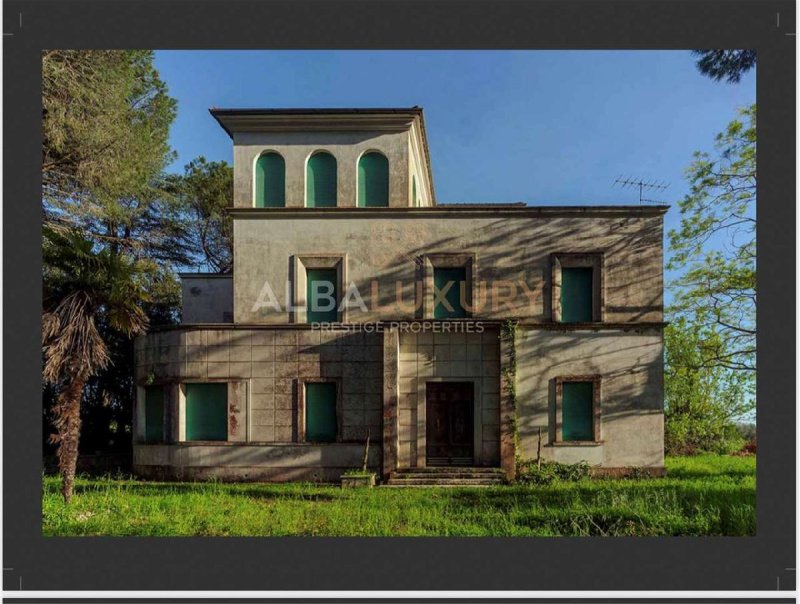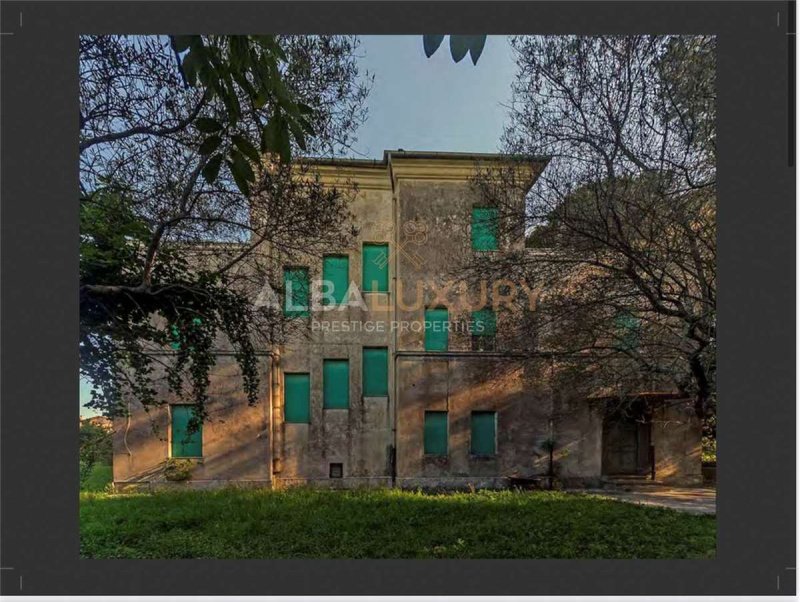This charming historic villa dating back to around 1935 is located in a strategic position in the municipality of Farnese and has considerable historical value.
At present the villa is in need of renovation to bring it back to its former glory.
Spread over two floors, on the ground floor is the living area with kitchen, dining room, a bathroom, a further room, a study room
Going up to the first floor we find 4 bedrooms and a bathroom and on the second floor a bedroom, two large terraces and a third covered terrace
Farnese is a typically medieval village, rising on a tuffaceous spur, west of Lake Bolsena.
The landscape that opens up in front of Farnese is very picturesque and faces in the south-eastern part Valle Cupa, a hilly area of tuffaceous origin. All around, the town is surrounded by lush vegetation, including the Lamone, a dense forest rich in plant and animal species.
The centre of Farnese is rich in buildings and remains from medieval times, including the famous 'pozzi da butto', large cylindrical wells dug directly into the tuff.
Like many of the towns in Tuscia, which rise on tuffaceous hills, Farnese is also subject to erosion due to the basement of the tuffaceous block on which the town rests. Many consolidation works have been carried out and are still in progress to fortify the basement.
There are many events that characterise the village, some of which include the Shepherd's Festival, the Beer Festival and Farnese in fiore.
A curiosity, due to its characteristics as a perfectly preserved medieval village, Farnese was chosen by director Luigi Comencini as the set for some shots of the screenplay Pinocchio.
自动翻译所用的语言
Questa affascinante villa storica risalente intorno al 1935 , si trova in una posizione strategica del comune di Farnese ed ha un valore storico di notevole importanza.
Attualmente la villa necessiterebbe di un intervento di ristrutturazione per riportarla agli antichi splendori
Si sviluppa su due piani , al piano terra si trova la zona giorno con cucina, sala da pranzo, un bagno, un'ulteriore sala, una stanza studio
Salendo al primo piano troviamo 4 camere da letto e un bagno e al secondo piano una camera da letto, due grandi terrazze e una terza terrazza coperta
Farnese è un borgo tipicamente medievale, che nasce su di uno sperone tufaceo, ad ovest del Lago di Bolsena.
Il paesaggio che si apre davanti Farnese è molto suggestivo e affaccia nella parte sud-est su Valle Cupa, una zona collinare di origine tufacea. Tutto intorno, il paese è circondato da una lussureggiante vegetazione, tra cui il Lamone, un fittissimo bosco ricco di specie vegetali ed animali.
Il centro di Farnese è ricco di edifici e resti di epoca medievale, tra cui i famosi “pozzi da butto”, dei pozzi cilindrici di grandi dimensioni, scavati direttamente nel tufo.
Come molti dei paesi della Tuscia, che sorgono su colline tufacee, anche Farnese è soggetto all'erosione dovuta al basamento su terreno arenaio del blocco tufaceo su cui poggia il paese. Molte opere di consolidamento sono state realizzate e sono tutt'ora in corso per fortificare il basamento.
Molti sono gli eventi che caratterizzano il paese, tra cui ne ricordiamo alcune: la Sagra della Pastorizia, la Festa della Birra e Farnese in fiore.
Una curiosità, per le sue caratteristiche di borgo medievale, perfettamente conservato, Farnese venne scelto dal regista Luigi Comencini, come set per alcune riprese dello sceneggiato Pinocchio.
CLASSE ENERGETICA: E
Diese charmante historische Villa aus der Zeit um 1935 befindet sich in strategischer Lage in der Gemeinde Farnese und hat einen beträchtlichen historischen Wert.
Derzeit ist die Villa in der Notwendigkeit der Renovierung, um es wieder zu seinem früheren Glanz zu bringen.
Auf zwei Etagen verteilt, befindet sich im Erdgeschoss der Wohnbereich mit Küche, Esszimmer, ein Badezimmer, ein weiteres Zimmer, ein Arbeitszimmer
In der ersten Etage befinden sich 4 Schlafzimmer und ein Badezimmer und in der zweiten Etage ein Schlafzimmer, zwei große Terrassen und eine dritte überdachte Terrasse.
Farnese ist ein typisch mittelalterliches Dorf, das sich auf einem Tuffsteinausläufer westlich des Bolsena-Sees erhebt.
Die Landschaft, die sich vor Farnese öffnet, ist sehr malerisch und liegt im südöstlichen Teil des Valle Cupa, einem hügeligen Gebiet tuffsteinhaltigen Ursprungs. Die Stadt ist von einer üppigen Vegetation umgeben, zu der auch der Lamone gehört, ein dichter Wald, der reich an Pflanzen- und Tierarten ist.
Das Zentrum von Farnese ist reich an Gebäuden und Überresten aus dem Mittelalter, darunter die berühmten "pozzi da butto", große zylindrische Brunnen, die direkt in den Tuffstein gegraben wurden.
Wie viele Städte in der Tuscia, die sich auf Tuffsteinhügeln erheben, ist auch Farnese aufgrund des Tuffsteinsockels, auf dem die Stadt ruht, der Erosion ausgesetzt. Es wurden und werden zahlreiche Konsolidierungsarbeiten durchgeführt, um das Fundament zu befestigen.
Zahlreiche Veranstaltungen prägen das Dorf, darunter das Hirtenfest, das Bierfest und Farnese in fiore.
Als Kuriosität wurde Farnese aufgrund seiner Eigenschaften als perfekt erhaltenes mittelalterliches Dorf von Regisseur Luigi Comencini als Kulisse für einige Aufnahmen des Drehbuchs Pinocchio ausgewählt.
Эта очаровательная историческая вилла, датируемая примерно 1935 годом, расположена в стратегическом месте в муниципалитете Фарнезе и имеет значительную историческую ценность.
В настоящее время вилла нуждается в ремонте, чтобы вернуть ей былую славу.
Расположенная на двух этажах, на первом этаже находится гостиная с кухней, столовая, ванная комната, еще одна комната, кабинет.
Поднявшись на второй этаж, мы обнаружим 4 спальни и ванную комнату, а на втором этаже - спальню, две большие террасы и третью крытую террасу.
Фарнезе - типично средневековая деревня, возвышающаяся на туфовом отроге, к западу от озера Больсена.
Пейзаж, открывающийся перед Фарнезе, очень живописен и обращен к юго-восточной части Valle Cupa, холмистой местности туфового происхождения. Повсюду город окружен пышной растительностью, включая Ламоне, густой лес, богатый видами растений и животных.
Центр Фарнезе богат зданиями и остатками средневековых времен, включая знаменитые "pozzi da butto", большие цилиндрические колодцы, вырытые прямо в туфе.
Как и многие города Тосции, возвышающиеся на туфовых холмах, Фарнезе также подвержен эрозии из-за подошвы туфового блока, на котором стоит город. Было проведено множество работ по укреплению фундамента, которые продолжаются и в настоящее время.
Для деревни характерно множество событий, некоторые из которых включают Пастуший фестиваль, Пивной фестиваль и Farnese in fiore.
Любопытно, что благодаря своим характеристикам прекрасно сохранившейся средневековой деревни, Фарнезе был выбран режиссером Луиджи Коменчини в качестве декорации для некоторых кадров сценария фильма "Пиноккио".


